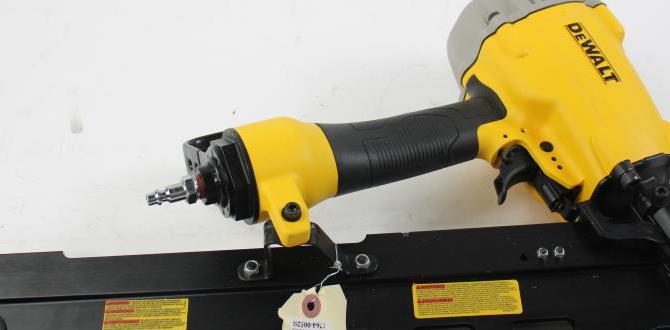Quick Summary:
Choosing a cordless nailer means looking beyond just nail-firing power to battery life that keeps you working. Our comparison reveals which batteries offer proven longevity, ensuring you finish projects without constant recharging. We’ll help you find the best dependable power source for your DIY needs at Nailerguy.
Table of Contents
Cordless Nailer Battery Life Comparison: Proven Power for Your Projects
Hey DIYers and workshop wizards! Jack Shaffer here from Nailerguy. Ever been in the middle of fastening a deck board or putting up some trim, only to have your cordless nailer sputter and die? It’s a super common frustration, right? That’s where understanding cordless nailer battery life becomes a game-changer. A powerful nailer is great, but if its battery quits before you do, it’s a real project stopper. Today, we’re diving deep into what makes a battery last, comparing different options, and helping you find the real “proven power” for your next build. Get ready to say goodbye to battery anxiety!
Why Battery Life Matters More Than You Think
When you’re eyeing that shiny new cordless nailer, it’s easy to get caught up in the features: the firing speed, the ergonomics, the type of nails it drives. But one of the biggest workhorses, the silent partner in all that nailing action, is the battery. Think about it: a nailer is only as good as the energy source keeping it alive.
A nailer with exceptional battery life means you can:
Complete a whole project without stopping to charge.
Carry fewer batteries around, saving space and weight.
Work outdoors or in locations far from a power outlet with confidence.
Maintain consistent power throughout your task, leading to cleaner finishes.
Without this power, even the best nailer can become a glorified paperweight. This comparison will arm you with the knowledge to pick a cordless nailer that won’t leave you hanging mid-job.
Understanding Battery Technology: What Powers Your Nailer?
Most cordless nailers today run on Lithium-Ion (Li-ion) batteries. This technology has revolutionized portable power tools, offering significant advantages over older battery types like NiCad (Nickel-Cadmium).
Here’s a quick rundown of what makes Li-ion great and what affects its life:
High Energy Density: Li-ion batteries pack a lot of power into a small, lightweight package. This means more runtime and less fatigue for you.
No Memory Effect: Unlike older batteries, you don’t need to fully discharge Li-ion batteries before recharging. You can top them up whenever needed without damaging their capacity.
Low Self-Discharge: They hold their charge for a long time when not in use, meaning a battery you charged last month will likely still have plenty of juice.
However, several factors influence how long a Li-ion battery will keep your nailer running:
Amp-Hour (Ah) Rating: This is the most crucial spec. It directly tells you how much capacity the battery has. A higher Ah rating means more runtime. For example, a 4.0Ah battery will generally last twice as long as a 2.0Ah battery under the same load.
Voltage (V): While not directly related to runtime, higher voltage often correlates with more power, which can sometimes lead to slightly quicker battery drain if the tool is working harder. Common voltages for nailers are 18V and 20V max (which are essentially the same 18V system).
Tool Efficiency: Some nailers are designed to be more power-efficient than others. A well-designed tool will draw less power from the battery.
Application: What are you doing? Driving thousands of small brads into soft pine uses less energy than sinking numerous long framing nails into hardwoods. The nailer has to work harder in the latter scenario, and the battery will drain faster.
Battery Age & Health: Like all batteries, Li-ion batteries degrade over time and with use. Their capacity will decrease, meaning they won’t hold as much charge as they did when new.
Environmental Conditions: Extreme temperatures (hot or cold) can negatively impact battery performance and lifespan.
Key Players: Top Cordless Nailer Brands and Their Battery Platforms
When we talk about cordless nailer battery life, we’re often talking about a brand’s entire battery ecosystem. Many brands use the same batteries across a wide range of their cordless tools, not just nailers. This is a huge advantage – if you invest in a brand’s platform, you can often buy bare tool nailers (without batteries) at a lower cost and use batteries you already own for drills, saws, and other tools.
Let’s look at some of the major players and what they offer in terms of battery power and longevity. We’ll focus on the popular 18V/20V MAX categories, as these are the most common for DIY and professional nailers.
DeWalt’s 20V MAX System
DeWalt is a powerhouse in the cordless tool world, and their 20V MAX system is incredibly popular amongst pros and serious DIYers. They offer batteries ranging from compact 1.5Ah packs to robust 5.0Ah and even 6.0Ah “Pro” batteries. The higher Ah numbers directly translate to longer runtimes.
Common Battery Sizes: 2.0Ah, 3.0Ah, 4.0Ah, 5.0Ah, 6.0Ah.
Pros: Excellent durability, wide range of tool compatibility, readily available. Higher Ah batteries provide sustained power for demanding tasks like framing.
Considerations: Can be an investment to build a battery collection.
Milwaukee’s M18 System
Milwaukee competes neck-and-neck with DeWalt, particularly in the professional ranks. Their M18 system is extensive, featuring their REDLITHIUM batteries in various capacities, including high-output options. Milwaukee’s “High Output” batteries are designed to deliver more power and run significantly cooler, which translates to extended runtime and battery life for high-demand tools like nailers.
Common Battery Sizes: 2.0Ah, 3.0Ah, 4.0Ah, 5.0Ah, and their High Output 3.0Ah, 4.0Ah, 6.0Ah, 8.0Ah, 12.0Ah.
Pros: Innovative battery management, High Output series offers exceptional performance for power-hungry tools, strong tool ecosystem.
Considerations: Often priced at a premium, but the performance justifies it for many users.
Ryobi’s ONE+ System
Ryobi targets the DIY homeowner and a more budget-conscious market with its ONE+ system, which boasts over 200 different tools that all run on the same battery platform. They offer a range of battery sizes, from smaller 1.3Ah to larger 4.0Ah and 6.0Ah options. While perhaps not as robust as professional-grade systems for constant heavy use, Ryobi batteries provide excellent value and more than enough power for typical home projects.
Common Battery Sizes: 1.3Ah, 1.5Ah, 2.0Ah, 3.0Ah, 4.0Ah, 6.0Ah, 9.0Ah.
Pros: Huge tool selection, very affordable entry point, excellent for occasional to moderate DIY use.
Considerations: May not hold up to the same daily abuse as professional brands, but battery life for typical DIY jobs is very good.
Ridgid’s 18V Brushless System
Ridgid offers a robust 18V system known for its durability and often comes with a lifetime service agreement on batteries (check current warranty terms). They provide a good range of battery capacities to meet different demands.
Common Battery Sizes: 2.0Ah, 4.0Ah, 5.0Ah, 6.0Ah.
Pros: Strong warranty, good performance, compatible with the Octane line of higher-demand tools.
Considerations: Tool selection might be slightly smaller than DeWalt or Milwaukee in some categories.
Cordless Nailer Battery Life: What Can You Expect?
Predicting exact nail counts per charge can be tricky, as it depends so heavily on the nailer model, the battery capacity, and the type of work. However, we can provide some general estimates and benchmarks to help you compare.
A good way to measure battery performance is through nail count per charge or runtime per charge. For a medium-duty nailer (like a brad nailer or finish nailer), you can often expect:
2.0Ah Battery: Anywhere from 500 to 1,000+ nails. Good for smaller projects, quick fixes, or when weight is a concern.
4.0Ah Battery: Typically 1,000 to 2,000+ nails. A great all-around choice for most DIY projects.
5.0Ah/6.0Ah Battery (or higher): Often 1,500 to 3,000+ nails. Excellent for larger jobs, continuous use, or when driving larger nails that demand more power.
Important Note: These numbers are estimates. A framing nailer driving 3-inch nails will chew through a battery pack much faster than a brad nailer sinking 1-inch brads. Always check manufacturer specifications and user reviews for more specific data on your intended nailer model.
Table: General Cordless Nailer Battery Life Estimates (18V/20V MAX Systems)
This table provides a general guideline for what you might expect from different battery capacities when using a typical finish or brad nailer. Remember, your mileage may vary significantly based on tool, application, and specific battery model.
| Battery Capacity (Ah) | Estimated Nail Count per Charge (General) | Ideal For | Pros | Cons |
|---|---|---|---|---|
| 1.5Ah – 2.5Ah | 500 – 1,200 | Small projects, trim work, quick fixes. | Lightweight, compact, lower cost. | Shorter runtime, may struggle with demanding tasks. |
| 3.0Ah – 4.0Ah | 1,000 – 2,000+ | Medium to large projects, general carpentry. | Good balance of runtime, weight, and cost. A versatile workhorse. | Slightly heavier than smaller batteries. |
| 5.0Ah – 6.0Ah | 1,500 – 3,000+ | Large projects, framing, deck building, frequent use. | Extended runtime, sustained power for heavy applications. | Heavier, more expensive, can make the tool feel front-heavy. |
| 8.0Ah+ (“High Output” on some brands) | 2,500 – 4,000+ | Heavy-duty professional use, very large projects. | Maximum runtime, consistent high power output. | Heaviest, most expensive option, can be bulky. |
Factors Influencing Real-World Battery Performance
Beyond the stated Ah, several other factors can influence how long your cordless nailer’s battery truly lasts on a job site.
Battery Chemistry and Design
While most are Li-ion, variations exist. Some manufacturers have proprietary battery management systems that optimize power delivery and heat dissipation. For instance, Milwaukee’s REDLITHIUM HIGH OUTPUT batteries are specifically engineered to deliver more power for demanding applications without overheating, allowing them to run longer under heavy load compared to standard batteries of the same Ah rating. Keep an eye on these specialized battery lines if your nailer usage is intensive.
Nailer Type and Size
Brad Nailers & Pin Nailers: These are generally the most battery-efficient. They drive small, thin fasteners with minimal air resistance. You can often get thousands of nails from a single charge.
Finish Nailers: These drive slightly larger nails. Battery life is still excellent, but expect fewer nails per charge than with brad nailers.
Framing Nailers & Palm Nailers: These are the power-hungry beasts. They drive much larger, thicker nails, often requiring more force and air volume. You’ll see significantly fewer nail counts per charge with these tools, especially when working with hardwoods or driving nails to full depth.
Work Environment
Temperature: Extremely hot or cold temperatures can reduce battery performance and even damage them over time. Avoid leaving batteries in a hot car or in freezing conditions for extended periods. For optimal performance, aim to use batteries at moderate temperatures.
Humidity: While less impactful than temperature, very high humidity can sometimes slightly affect battery charging and discharge cycles.
Maintenance and Care
Proper care ensures your batteries reach their maximum potential lifespan and capacity.
Avoid Deep Discharges: While Li-ion doesn’t have a “memory effect,” completely draining the battery every single time can, over the very long term, slightly accelerate degradation.
Clean Contacts: Occasionally, wipe the battery’s electrical contacts and the tool’s contacts with a clean, dry cloth to ensure good electrical connection.
Store Properly: Store batteries in a cool, dry place. If storing for an extended period, it’s often recommended to leave them partially charged (around 50-70% capacity).
Use the Right Charger: Always use the charger designed for your specific battery system.
Comparing Battery Performance: Real-World Scenarios & Brands
Let’s get practical. Imagine you’re building a fence or installing baseboards.
Scenario 1: Installing Trim in a New House
You’ll be using a 16-gauge finish nailer or a 18-gauge brad nailer, driving perhaps 500-1000 nails of 1.5 to 2 inches.
DeWalt 20V MAX 4.0Ah: Likely to get you through this entire job and more. You might even use only half the battery charge.
Milwaukee M18 5.0Ah: Similar performance, giving you plenty of power and runtime.
Ryobi ONE+ 4.0Ah: Excellent for this application. Should comfortably handle the job without a recharge.
Scenario 2: Framing a Small Deck or Shed
This involves a framing nailer driving 3-inch nails, likely in denser lumber. You might drive 200-300 nails for a small project, but each nail requires more power.
DeWalt 20V MAX 6.0Ah: This is where the higher capacity batteries shine. You’ll get through the project, but it will be more demanding on the battery.
Milwaukee M18 High Output 6.0Ah: Expect superior performance here. The High Output battery will likely deliver more consistent power throughout and potentially last longer than a standard 6.0Ah from another brand under this heavy load.
Ridgid 18V 5.0Ah: Will likely get the job done, but you might want a spare battery charged and ready if you’re working continuously.
Brand Ecosystem Advantage:
If you already own tools from a particular brand, sticking with their battery platform is almost always the most cost-effective and convenient choice. DeWalt users will benefit from using their existing 20V MAX batteries with a DeWalt nailer. Likewise, Milwaukee users with M18 batteries will find their existing packs perfectly suited for an M18 nailer. This compatibility is a huge part of the “proven power” you’re investing in.
External Resource: For a deeper dive into battery technology and its impact on tool performance, check out resources from reputable organizations like the U.S. Department of Energy’s Battery Research and Development page.
Extending Your Battery’s Life and Performance
Want to get the most out of every charge and the longest life out of your batteries? Here are some practical tips:
1. Charge Smart:
Avoid charging a hot battery immediately after intense use. Let it cool down for a bit.
Don’t leave batteries on the charger indefinitely after they’re full, especially with older charger models. Most modern chargers have a maintenance mode, but it’s still good practice to disconnect when not in use for extended periods.
2. Manage Your Batteries:
Don’t buy more batteries than you need initially. Start with one or two high-capacity batteries if you plan on doing larger projects.
Rotate your batteries: If you have multiple, use them evenly. This prevents one battery from getting significantly older or more worn than others.
3. Keep Them Clean:
Battery contacts can accumulate dust and debris. Gently clean them periodically with a lint-free cloth or electrical contact cleaner. A clean connection ensures efficient power transfer.
4. Temperature Control:
Store your batteries in a cool, dry environment. Avoid extreme heat (like direct sun or a hot car) and freezing temperatures. Ideal storage is around 40-70°F (4-21°C).
5. Know Your Tool:
Understand the power demands of your specific nailer. A framing nailer will always use more power than a brad nailer. Match the battery capacity to your typical project size.
6. Listen to Your Tool:
* If your nailer’s performance starts to noticeably decrease even with a “full” battery, it might be nearing the end of its usable life cycle.
FAQ: Your Cordless Nailer Battery Questions Answered
Q1: How many nails


